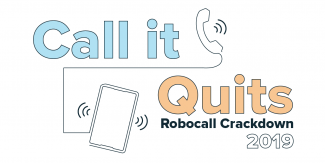Operation Call it Quits: Strengthening Efforts to Stop Robocalls
If you feel like recently you’ve been getting more robocalls (a call that uses an automated dialer to deliver a pre-recorded message), you’re not alone. In May 2019, U.S. households received more than 4.7 million robocalls—an increase of over 17% from the previous year. (In fact, while writing this blog, the writer received a robocall!)
To help consumers protect themselves against these illegal calls, AG Racine has joined a group of attorneys general and the Federal Trade Commission (FTC) in a new public education campaign called “Operation Call it Quits.” This campaign teaches consumers how to stop unwanted calls on a mobile phone, on a landline, and if they’re home phone uses the internet (VoIP). This campaign is part of OAG’s ongoing effort to help stem the tide of these pre-recorded calls. AG Racine is also part of a bipartisan working group of Attorneys General that works to promote consumer education and the development of technology-based solutions to block robocalls and combat caller ID spoofing, where robocallers mimic a recipient’s area code on their caller ID to increase the likelihood that the recipient will answer the phone.
Below are six ways you can reduce the number of robocalls you receive:
- Register on the national “Do Not Call” list. While the national Do Not Call list is not a foolproof safeguard against robocallers, it is still a good first line of defense to protect yourself. You can call 888-382-1222 or visit www.donotcall.gov to register your phone number.
- Do not answer anonymous calls. If you do not recognize a caller, do not answer the phone and let it go to voicemail or an answering machine. Often telemarketers will keep calling a phone number if they know a live person will pick up the phone.
- If you accidentally answer a robocall, just hang up. If you press any numbers or answer questions, it could lead to more calls.
- Use a blocking service. There are call blocking smartphone apps and voicemail services offered that may be used to block unwanted calls.
- Think twice before sharing your phone number. Each time you share your number with a sign-up list, this increases the likelihood that either the recipient will call you or will sell your number to another telemarketer.
- Submit a complaint—even if you receive a robocall and are not scammed out of money: Submit a complaint to OAG by calling (202) 442-9828 or emailing consumer.protection@dc.gov. You may also submit a complaint to the Federal Trade Commission by visiting ftc.gov/complaint or calling (877) 832-4357. Your complaints help us keep track of illegal and unwanted robocalls. The FTC analyzes complaint data and trends to identify illegal callers based on calling patterns. They also use additional information you report, like any number you’re told to call back, to track down scammers.
The Office of the Attorney General works to educate District residents about their consumer rights, responds to individual consumer complaints, and takes appropriate law enforcement action when possible. Browse OAG’s Consumer Protection Library to learn how to protect yourself from common scams.

